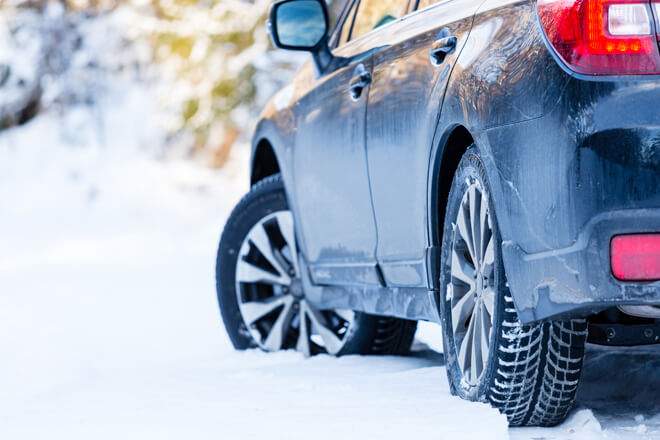Before you get your all-wheel drive in the snow or ice, you must know how to drive in snow with AWD. It isn’t hard; plus, four-wheel control makes it easier to handle your car in the snow, except that stopping is tougher than it would in two-wheel. In this post, I will show you how to drive in snow with AWD alongside some safety tips you should utilize.
To drive in the snow with AWD, you’d need 50% tires and 50% driving skills. You will have to go slow and drive like a learner. AWD vehicles can help you tackle unplowed roads, get out of snowed-in spots, and accelerate safely on slick surfaces. But the AWD car should come with a winter tire, or else the car won’t be capable of all these.
AWD vehicles can help you get out of snowed-in parking spots, tackle unplowed roads and accelerate on slick surfaces. But without winter tires, they’re not nearly as capable as they can be. AWD does little to aid turning and braking on snow and ice vs. a two-wheel-drive vehicle equipped with all-season tires.
Having an AWD drivetrain is not very relevant, although it adds to seamless driving. Nonetheless, it is important you know about driving in the snow.
Meanwhile, having snow tires could be insignificant, too. Skills are what counts, and it is advisable to prepare your mind. Snow tires and a drivetrain merely enhance driving, while safe driving depends on your skills.
Can you use AWD in the snow?

Yes, you can use AWD or four-wheel drive in the snow safely. AWD is also responsive with all-season tires in moderate and light snow, but not when you’re stopping the vehicle. Most of the time, you’d learn that AWD makes driving in the snow feel like you’re handling a tank. This claim is not entirely valid even though all-wheel-drive improves handling in slick conditions. Make sure to get snow or winter tires to improve driving, especially on ice.
How to Drive in Snow with AWD or Ice
-
Prepare Your Vehicle
To drive in snow with AWD, first, you must prepare your vehicle and check that every component, including the hazard light, is functional. All-wheel-drive enhances driving in the snow but not so much on the ice.
Icy conditions require that you drive cautiously, and you must eliminate fear to arrive at your destination without crashing the vehicle.
The rule of thumb when getting on the snow or ice is “snow tires” and you want to have them ready for a better driving experience. Don’t enter the snow on a flat tire.
You’d also need the best windshield wiper fluid like Rain-X to increase your driving visibility.
-
Watch Your Speed
Four-wheel-drive helps the vehicle to remain straight in the snow. When you are at high speeds, this functionality reduces, and you may lose control of the vehicle.
You’d want to reduce your speed by 50% of the road limit and keep your hazard lights on for visibility.
-
Disable Traction
A typical traction-control system will stop a vehicle if the tires spin while you go a snowy hill. To avoid this problem, disable traction control. If traction control is not an option in your car, speed up to gain momentum, but do not match the gas excessively to avoid losing control.
When you go up a steep driveway in the snow, brake pulsing might reduce the car speed or stop the car. Moreover, one tire begins to spin, but this would not necessarily be the case in an AWD, though.
-
Free the Brakes
Do not match the brakes suddenly if you must avoid a wreck. Make sure to anticipate stops long enough, and note that AWD does not assist much when stopping the car in the snow.
Release the gas gently to reduce the speed and pump the brakes gently. You may hold down the brake pedal to enable ABS (Anti-lock Brake System) in the supported vehicle.
When making curves on snowy roads, do not go faster. Otherwise, your vehicle’s front wheels will corkscrew, and the vehicle keeps going instead of turning. You can correct the issue by releasing the gas.
-
Accelerate Gently
Accelerating gently is one of your best advice to drive in snow with AWD. Driving slowly in the snow is imperative, especially when on the ice. Make sure not to accelerate unnecessarily, except you feel traction tire traction.
Regardless of the traction you get, however, keep the speed between 30mph and 40 mph, especially on icy conditions on side roads or freeways. You may go slower, though, depending on the number of road users and snow severity.
If you feel your car sliding, remain calm and steer the wheel as you would ordinarily.
-
Leave Space for Vehicles Ahead
Driving is not predictable in icy or snowy conditions. Typically, you’d keep 1-3 seconds room, but it’s recommended to stay at least 5 seconds from the vehicle ahead in the snow. It gives you enough room to react to sudden stops. Plus, vehicles are not responsive to slippery conditions.
-
Always watch your Side
Always watch your side when you drive in snow with AWD. Note that you are not the only road user. Expect some old-lady style drivers, but make sure not to be one of them.
Besides, other road users may not use snow tires or have AWD to enhance handling, and they may slide more often. Even with AWD and snow tires, expect annoying drivers, though; you might be hit at any time, especially when there is no room for reaction.
-
Avoid Panic Decisions
When you drive in snow with AWD, you sometimes encounter times when you panic and react hastily to situations – which is certainly due to weather conditions. When you panic, you may lose grip, and the vehicle slides, not the experience you want. Sometimes, the sudden reaction tempts you to overreact or freeze, and it may not end amicably.
Stay calm and think ahead before making decisions. Do not match the gas pedal and avoid braking suddenly.
Should I turn on the AWD lock-in snow?
You may turn on an AWD lock in the snow but use it only when getting the car out of the snow.
Is AWD better than FWD in Snow?
Which is better between AWD and FWD or even RWD? Generally, AWD is better than a two-wheel-drive since all four wheels are engaged to move the vehicle. When you include modern traction and stability controls, AWD performs better in the snow and ice than two-wheels.
Vehicles in the road have 4-wheel braking. Most of the time, accidents in the snow happen when a car fails to stop or is responsive to steering input immediately.
Suppose your vehicle is FWD and has all-season tires. When you switch to AWD, the vehicle’s abilities do not improve steering and braking in icy or snowy conditions to a larger extent. However, switching to snow tires enhances steering and improves speed control in the snow or ice.
Final Thoughts
Driving in snow is not difficult with AWD, although it is untrue to claim that AWD makes driving convenient entirely. The best practice is to get snow tires, and your driving skills factor in your ability to drive in snow.
Moreover, how much snow you get and vehicle ground clearance determine vehicle responsiveness in the snow. In essence, stay calm and attempt to predict other road users while contributing your best on the road.
![What is Payment Packing Scam [Dealer Crime Watch] What is Payment Packing Scam [Dealer Crime Watch]](https://sanedriver.org/wp-content/uploads/2020/12/payment-packing-211x150.jpg)

